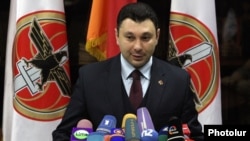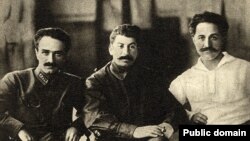A leading political ally of President Serzh Sarkisian said on Friday that he is proud of Anastas Mikoyan, an Armenian-born close associate of Joseph Stalin whose statue is due to be erected in Yerevan soon.
Eduard Sharmazanov, a deputy parliament speaker and the spokesman for Sarkisian’s Republican Party of Armenia (HHK), described Mikoyan as a “historic figure” who helped to avert another world war.
Sharmazanov emphasized the fact that he was born and grew up in Alaverdi, an industrial town in northern Armenia adjacent to the village of Sanahin, Mikoyan’s birthplace. “I am originally from Alaverdi and I always lay flowers to the [Sanahin] statue of the Mikoyan brothers,” he said.
“A Third World War did not break out also because of our compatriot,” Sharmazanov claimed, alluding to Mikoyan’s involvement in defusing the 1962 Cuban missile crisis that left the Soviet Union and the United States on the brink of a nuclear war.
Armenian civic campaigners, human rights activists and some opposition parties vehemently objecting to the planned monument believe that Mikoyan (1895-1978) should be remembered for other deeds. They single out his participation in Stalin’s Great Purge that began in 1937 and led to the deaths and imprisonment of millions of people in the Soviet Union.
As a member of Stalin’s Politburo, Mikoyan was dispatched to Soviet Armenia to oversee the mass arrests and executions of local Communists and intellectuals. His complicity is certified by a 1937 letter sent to Stalin by the then Soviet secret police chief. It said Mikoyan is asking for permission to execute an additional 700 “anti-Soviet elements.”
Sharmazanov, who is a historian by education, dismissed these arguments, saying that even Western countries have built monuments to their former leaders guilty of mass deaths. “Isn’t Napoleon a hero to the French?” he said. “Isn’t Oliver Cromwell, whose hands were stained with blood during the English revolution, a hero [in Britain?]”
The ruling party figure at the same time stopped short of voicing support for the municipal administration’s decision to put the statue in the city center. “I wouldn’t want to see statues of statesmen erected through fights,” he said ambiguously.
Yerevan Mayor Taron Markarian has said that his administration’s decision to erect the controversial monument, approved by the city council, needs to be endorsed by the national government. The latter has yet to make a decision.
“They are presenting to us an idol, a symbol of blood and opportunism who for decades was a state figure in another country and who oversaw the destruction of the First Armenian Republic,” said Bagrat Yesayan of the Armenian Revolutionary Federation (Dashnaktsutyun).
The short-lived republic was founded and governed by Dashnaktsutyun until being forcibly incorporated into Bolshevik Russia in 1920-1921. Thousands of Dashnaktsutyun members and other Armenians fled the country as a result.
Mikoyan was a prominent Bolshevik figure in the South Caucasus at the time and played a major part in the Soviet takeover. Yesayan said that just like Stalin, he supported Nagorno-Karabakh’s incorporation into Soviet Azerbaijan.
Yesayan, who leads Dashnaktsutyun’s Yerevan chapter, also told RFE/RL’s Armenian service (Azatutyun.am) that his opposition party has decided to organize a conference of historians who will discuss Mikoyan’s role in Soviet Armenian history in detail.
The Dashnaktsutyun branch condemned the planned statue as “blasphemy” in a statement issued earlier this week.
Eduard Sharmazanov, a deputy parliament speaker and the spokesman for Sarkisian’s Republican Party of Armenia (HHK), described Mikoyan as a “historic figure” who helped to avert another world war.
Sharmazanov emphasized the fact that he was born and grew up in Alaverdi, an industrial town in northern Armenia adjacent to the village of Sanahin, Mikoyan’s birthplace. “I am originally from Alaverdi and I always lay flowers to the [Sanahin] statue of the Mikoyan brothers,” he said.
“A Third World War did not break out also because of our compatriot,” Sharmazanov claimed, alluding to Mikoyan’s involvement in defusing the 1962 Cuban missile crisis that left the Soviet Union and the United States on the brink of a nuclear war.
Armenian civic campaigners, human rights activists and some opposition parties vehemently objecting to the planned monument believe that Mikoyan (1895-1978) should be remembered for other deeds. They single out his participation in Stalin’s Great Purge that began in 1937 and led to the deaths and imprisonment of millions of people in the Soviet Union.
As a member of Stalin’s Politburo, Mikoyan was dispatched to Soviet Armenia to oversee the mass arrests and executions of local Communists and intellectuals. His complicity is certified by a 1937 letter sent to Stalin by the then Soviet secret police chief. It said Mikoyan is asking for permission to execute an additional 700 “anti-Soviet elements.”
Sharmazanov, who is a historian by education, dismissed these arguments, saying that even Western countries have built monuments to their former leaders guilty of mass deaths. “Isn’t Napoleon a hero to the French?” he said. “Isn’t Oliver Cromwell, whose hands were stained with blood during the English revolution, a hero [in Britain?]”
The ruling party figure at the same time stopped short of voicing support for the municipal administration’s decision to put the statue in the city center. “I wouldn’t want to see statues of statesmen erected through fights,” he said ambiguously.
Yerevan Mayor Taron Markarian has said that his administration’s decision to erect the controversial monument, approved by the city council, needs to be endorsed by the national government. The latter has yet to make a decision.
“They are presenting to us an idol, a symbol of blood and opportunism who for decades was a state figure in another country and who oversaw the destruction of the First Armenian Republic,” said Bagrat Yesayan of the Armenian Revolutionary Federation (Dashnaktsutyun).
The short-lived republic was founded and governed by Dashnaktsutyun until being forcibly incorporated into Bolshevik Russia in 1920-1921. Thousands of Dashnaktsutyun members and other Armenians fled the country as a result.
Mikoyan was a prominent Bolshevik figure in the South Caucasus at the time and played a major part in the Soviet takeover. Yesayan said that just like Stalin, he supported Nagorno-Karabakh’s incorporation into Soviet Azerbaijan.
Yesayan, who leads Dashnaktsutyun’s Yerevan chapter, also told RFE/RL’s Armenian service (Azatutyun.am) that his opposition party has decided to organize a conference of historians who will discuss Mikoyan’s role in Soviet Armenian history in detail.
The Dashnaktsutyun branch condemned the planned statue as “blasphemy” in a statement issued earlier this week.





